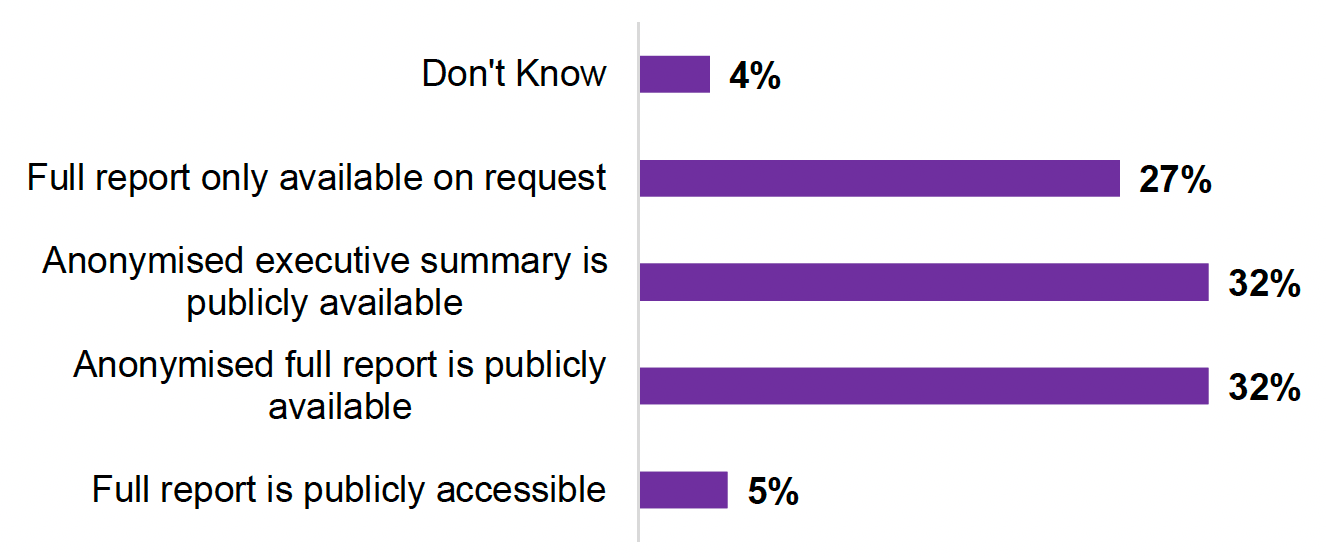Domestic homicide reviews: consultation analysis
We undertook a period of consultation and targeted engagement to inform the development of a Domestic Homicide Review model for Scotland. Those with lived experience of domestic abuse and those working in the field shared their views on fundamental aspects of the model.
E) Reporting and Learning
This section asked about the report following a Domestic Homicide Review. Participants were asked their views on how to ensure that the learning and recommendations are meaningful and will lead to change.
Families, friends, and relevant professionals will be given the opportunity to review the report before submission to ensure that their accounts are accurately reflected.
28. Responsible organisation: To which organisations should the Domestic Homicide Review report be submitted once completed? For example, Scottish Government.
Participants were asked which organisations should the Domestic Homicide Review report be submitted to once completed. There was mixed feedback regarding the responsible organisations. The Scottish Government featured in most responses, either as the organisation in charge, or involved in other ways. Some suggestions were that the Scottish Government could act as a Chair of a Domestic Homicide Review board. Others respondents suggested that the Scottish Government could work with a commissioning body, the courts, or victim support organisations.
Some respondents considered that the Scottish Government may not have the relevant skills and experience to provide oversight of report quality, and that ownership should remain local to maximise the potential for learning.
Others suggested organisations included: Multi-Agency Public Protection Arrangements (MAPPA) Strategic Oversight Group, Social Work, Police Scotland, the Courts and Local Authorities.
29. Dissemination of learning: How should the learning from the finalised Domestic Homicide Review report be made available to those beyond the family and agencies involved?
Respondents were asked how learning from the finalised Domestic Homicide Review report should be made available beyond the family and agencies involved. There was a tie (32%) between respondents selecting the full anonymised report being publicly available and those who selected an anonymised executive summary is publicly available. Over a quarter of respondents (27%) selected that the full anonymised report should only be made available for legitimate purposes. Only 5% of respondents selected the full report to be publicly accessible.

Respondents with lived experience felt that the perpetrator should not have access to the report, and that there was also no need for it to be published. A discussion about this led those with lived experience to question whether the dissemination of findings could be informed by the bereaved family.
Other respondents said that reports need to be publicly available and there needs to be a centralised source where they can be accessed so that different organisations and Police forces/ stations are able to learn from them. Professional respondents believed that the report should include demographic information (such as: ethnicity, dis/ability), to explore the implications of discrimination in the victim and their family’s experiences of both accessing services prior to and since the homicide.
Respondents highlighted that Domestic Homicide Reviews are about learning, transparency and sharing of lessons. People must therefore be confident enough to identify issues and failures with public shame and embarrassment. It was also stated that it is critical to protect families from the public fall out of a review. Sharing the full report was seen as unnecessary by most respondents with the need for anonymization at the very least. However, caution was advised when anonymising reports, not to de-humanise the victim/s and survivor/s.
It was also suggested that being able to access the report and the lessons through various platforms would be helpful. This access would be given upon approval to those who can contribute to learning.
30. Other ways to ensure learning: Are there other means to ensure learning in addition to a report? For example, through a learning event with the organisations that were in contact with the victim and perpetrator.
“Learning events can be excellent conduits for learning, summarised briefings, agencies meeting the bereaved families and holding events at which victims speak.” Professional respondent with lived experience
Professional respondents and professionals with lived experience were asked to share their views on other means to ensure learning in addition to a report. Many respondents agreed that local and national learning events would be incredibly useful. Learning summaries for wider dissemination was suggested and Action Learning Sessions to ensure active learning. Additionally, a clear dissemination process for each review was highlighted. Other ways that respondents identified for ensuring learning are detailed in Figure (39) below.

31. Implementation of recommendations: What needs to be in place to support recommendations to be implemented successfully across organisations?
Professional respondents and professionals with lived experience were asked what needs to be in place to support recommendations to be implemented successfully across organisations. The importance of resources and funding were cited by many respondents as pivotal to ensure recommendations have an environment in which they can be implemented. Additionally, respondents think legislation and supporting guidance around the domestic homicide review process would help support the implementation of recommendations.
Ensuring strategic buy in with a strong leadership (through a governing body for instance) could provide a clear pathway of process after the conclusion of a domestic homicide review. This would help promote a continuous improvement culture. It was also noted that appropriate people at the appropriate level are involved. Other ways to support recommendations shared by respondents are:
- Debrief sessions
- Implementation plans
- Key people having accountability
- Realistic recommendations
- Sharing examples of best practice, such as best practice sheets/process sheets
It was also stated that if recommendations cross over boundaries this needs to be agreed. The wellbeing of the professionals involved was also cited as an important consideration and to ensure that the work culture is trauma informed and includes staff wellbeing.
Contact
Email: dhrmodel@gov.scot
There is a problem
Thanks for your feedback